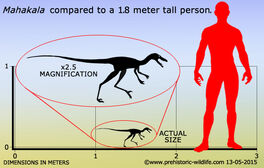| Mahakala Temporal range: Late Cretaceous | |
|---|---|

| |
| Reconstruction of Mahakala by Gabriel N. U. | |
| Scientific classification | |
| Kingdom: | Animalia |
| Phylum: | Chordata |
| clade: | Dinosauria |
| Order: | Saurischia |
| Suborder: | Theropoda |
| Family: | †Dromaeosauridae |
| Subfamily: | †Halszkaraptorinae |
| Genus: | †Mahakala Turner et al., 2007 |
| Type species | |
| †Mahakala omnogovae Turner et al., 2007 | |
Mahakala ( from संस्कृतम् (Sanskrit); named for one of the eight protector deities in Tibetan Buddhism) is an extinct genus of halszkaraptorine dromaeosaurid theropod dinosaur from the Djadokhta Formation of Ömnögovi, Mongolia, of the Upper Cretaceous. The only known species is M. omnogovae, known from a partial skeleton dating to the Campanian age (about 80 mya).
Mahakala is without doubt one of the smallest dromaeosaurs ever discovered, and even one of the smallest non-avian dinosaurs as well as also being one of the most primitive dromaeosaurs. Along with the collectively named, large troodont Zanabazar, this creature was discovered in Mongolia. Despite being so primitive, it lived in the Late Cretaceous, signalizing that it had a niche that worked out with its primitive form.
Description[]

Skeletal of Mahakala
The holotype specimen of Mahakala (IGM 100/1033), a partial skeleton including skull bones, vertebrae, limb bones, and portions of the pelvis and shoulder girdle, was found in the sediments of the Gobi Desert. Although this individual was small, comparable in size to Archaeopteryx, Caudipteryx, and Mei, it was close to adulthood. This genus can be distinguished from other paravians (dromaeosaurids, troodontids, and birds) by details of the ulna, thighbone, ilium, and tail vertebrae. Like Archaeopteryx and derived dromaeosaurids, but unlike basal troodontids and other dromaeosaurids, the middle (third) metatarsal was not compressed, suggesting that the uncompressed version was the basal version. It had a typical dromaeosaurid form of the second toe, with an expanded claw.[1]
Classification[]
A phylogenetic analysis performed by Turner and colleagues, who described the specimen, found Mahakala to be the most basal known dromaeosaurid. Their results, along with the small size of other theropods found at the base of paravian lineages, suggest that small size was not an innovation of early birds, but a common trait of early paravians; small size would have preceded flight and would not have been a special avian autapomorphy as the result of a size squeeze. Like birds, troodontids and dromaeosaurids were not small throughout their evolutionary history, and showed size increases among several different lineages. Mahakala has a combination of characteristics found among basal troodontids and birds, but lacks some that are present in more derived dromaeosaurids.[1] A study in 2017 found that Mahakala was a member of the enigmatic, basal subfamily Halszkaraptorinae.[2]
The cladogram below is based on the phylogenetic analysis conducted in 2017 by Cau et al. using updated data from the Theropod Working Group in their description of Halszkaraptor.[2]
| Dromaeosauridae |
| |||||||||||||||||||||||||||||||||||||||||||||||||||||||||||||||||||||||||||||||||||||||||||||||||||||||||||||||||||||||||||||||||||||||||||||||||||||||||
Paleoecology[]

Accounting its extremely tiny size, Mahakala most likely chased bugs, although its enlarged toe claws allowed it to easily take down small reptiles and mammals., and maybe even tiny alverezsaurs like Parvicursor. It would have faced threats from the troodonts like Saurornithoides and also from the larger, more advanced dromaeosaur Velociraptor. Mahakala went extinct shortly before the KT extinction, likely because of being overhunted from an abundance of predators.

